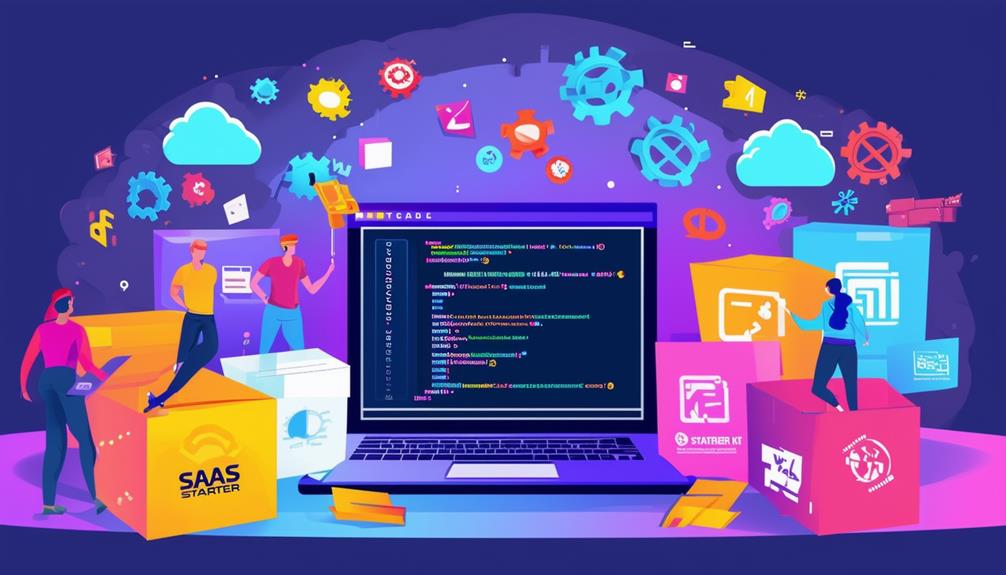You’ve got a great idea for a SaaS product, but where do you start? Implementing a starter kit can save you countless hours of development time, allowing you to focus on your unique value proposition. By leveraging pre-built components and best practices, you’ll accelerate your time-to-market and reduce technical debt. However, not all starter kits are created equal, and choosing the wrong one can lead to headaches down the road. To maximize your efficiency and set your project up for success, you’ll need to contemplate several key strategies. Let’s explore the top 10 time-saving approaches that can make or break your SaaS implementation.
Choose the Right Starter Kit
Selecting the ideal SaaS starter kit is vital for your project’s success, as it’ll greatly impact your development speed, scalability, and overall product quality. To make the right choice, consider these key factors:
- Technology stack: Confirm the kit aligns with your team’s expertise and project requirements. Popular options include MERN (MongoDB, Express.js, React, Node.js) or MEAN (MongoDB, Express.js, Angular, Node.js) stacks.
- Features and functionality: Look for kits that offer essential SaaS components like user authentication, subscription management, and billing integration. This’ll save you significant development time.
- Scalability: Choose a kit that can handle growing user bases and increasing data volumes. Evaluate its database design and API architecture.
- Community support: Opt for kits with active communities and regular updates. This guarantees long-term support and access to resources.
- Customization options: Select a kit that allows easy modifications to fit your specific needs without requiring a complete overhaul.
Customize Authentication and User Management
Once you’ve chosen your starter kit, it’s time to tailor the authentication and user management systems to fit your specific SaaS requirements.
Start by evaluating the existing authentication methods provided by your starter kit. Most kits offer basic email/password login, but you’ll likely need to implement additional options such as social media logins or single sign-on (SSO) for enterprise clients.
Next, focus on user management features. Implement role-based access control (RBAC) to define user permissions and restrict access to sensitive areas of your application. Create a user profile system that allows customers to manage their account details, preferences, and subscription information.
Don’t forget to include features like password reset, email verification, and two-factor authentication to enhance security.
Consider integrating a third-party identity provider like Auth0 or Okta to offload complex authentication tasks and improve scalability. These services often provide additional features like user analytics and fraud detection.
Implement Scalable Database Architecture
A scalable database architecture forms the backbone of your SaaS application, guaranteeing it can handle growing data volumes and user loads without compromising performance.
To implement this, start by choosing a database system that supports horizontal scaling, such as MongoDB or Amazon DynamoDB. These NoSQL options allow you to distribute data across multiple servers, enhancing both capacity and speed.
Implement database sharding to partition your data across multiple machines. This technique improves query performance and allows for easier scaling as your user base grows.
Consider using a caching layer, like Redis, to reduce database load and speed up frequent queries. It’s essential to design your schema with scalability in mind, avoiding complex joins and favoring denormalization where appropriate.
Employ connection pooling to manage database connections efficiently, reducing overhead and improving response times.
Regularly monitor your database performance using tools like Datadog or New Relic, and set up automated alerts for potential issues.
Implement a robust backup and recovery strategy to guarantee data integrity and minimize downtime.
Integrate Essential Third-Party Services
To build a robust SaaS starter kit, you’ll need to integrate essential third-party services that enhance functionality and streamline development. Start by incorporating authentication services like Auth0 or Firebase Authentication to handle user management securely. These solutions save time and guarantee compliance with industry standards.
Next, implement a payment gateway such as Stripe or PayPal to process transactions efficiently. These platforms offer robust APIs and handle complex payment logic, allowing you to focus on core features. For communication, integrate email services like SendGrid or Mailgun to manage transactional emails and marketing campaigns.
Consider adding analytics tools like Google Analytics or Mixpanel to track user behavior and gather insights. These services provide valuable data for decision-making and product improvement. For error tracking and monitoring, implement solutions like Sentry or New Relic to identify and resolve issues quickly.
Lastly, integrate cloud storage services like Amazon S3 or Google Cloud Storage for scalable file management. These services offer reliable and cost-effective storage solutions for your SaaS application.
Optimize for Performance
Your SaaS starter kit’s performance can make or break user experience, so it’s crucial to optimize every aspect of your application for speed and efficiency.
Start by implementing efficient database queries and indexing to reduce load times. Use caching mechanisms like Redis or Memcached to store frequently accessed data, minimizing database hits.
Optimize your front-end by minifying and compressing CSS, JavaScript, and HTML files. Leverage browser caching and content delivery networks (CDNs) to serve static assets faster. Implement lazy loading for images and modules to prioritize critical content.
On the back-end, use asynchronous processing for time-consuming tasks and implement a job queue system like Sidekiq or Celery. This approach prevents long-running processes from blocking user interactions. Consider adopting serverless architectures for specific functions to improve scalability and reduce infrastructure costs.
Monitor your application’s performance using tools like New Relic or Datadog. Regularly analyze metrics to identify bottlenecks and optimize accordingly. Implement load testing to verify your SaaS can handle expected traffic volumes.
Implement Robust Error Handling
Robust error handling forms the backbone of a reliable SaaS starter kit, guaranteeing graceful failure management and improved user experience.
To implement this effectively, you’ll need to focus on several key areas. First, categorize potential errors into types such as network issues, user input errors, and system failures. This categorization will help you create targeted handling strategies for each.
Next, implement try-catch blocks throughout your codebase to capture and log errors. Use descriptive error messages that provide actionable information for both users and developers. Consider implementing a centralized error logging system to track and analyze issues over time.
Don’t forget to handle asynchronous errors in JavaScript, using async/await or .catch() methods on Promises. For API calls, implement proper HTTP status code handling and provide meaningful responses to clients.
Create user-friendly error pages and messages that guide users on how to resolve issues or contact support. Additionally, set up automated alerts for critical errors to guarantee your team can respond quickly to major issues.
Customize UI/UX Components
While error handling guarantees functionality, a well-crafted UI/UX elevates your SaaS starter kit’s user experience and sets it apart from competitors. To customize your UI/UX components effectively, focus on these key strategies:
First, implement a modular design system. Create a library of reusable components, such as buttons, forms, and navigation elements. This approach assures consistency across your application and speeds up development time. Use tools like Storybook to document and showcase your components.
Next, prioritize responsiveness and accessibility. Confirm your UI adapts seamlessly to various screen sizes and devices. Implement WCAG guidelines to make your SaaS accessible to all users, including those with disabilities.
Incorporate user feedback and analytics into your design process. Use tools like Hotjar or FullStory to gather insights on user behavior and pain points. Regularly conduct A/B tests to optimize your UI/UX based on data-driven decisions.
Lastly, consider implementing a theming system. This allows for easy customization of colors, typography, and other visual elements, enabling you to tailor the look and feel of your SaaS to different clients or use cases without extensive code changes.
Set Up Automated Testing
Automated testing forms the backbone of a reliable SaaS starter kit, guaranteeing code quality and reducing the risk of bugs in production.
To set up effective automated testing, start by implementing unit tests for individual components and functions. Use tools like Jest or Mocha for JavaScript-based projects, or pytest for Python applications. Aim for at least 80% code coverage to catch most potential issues.
Next, incorporate integration tests to verify the interaction between different parts of your system. Tools like Selenium or Cypress can help automate browser-based testing for your SaaS frontend. For backend API testing, consider using Postman or REST-assured.
Don’t forget to implement end-to-end (E2E) tests that simulate real user scenarios. These tests guarantee your entire application functions correctly from start to finish. Tools like Puppeteer or Cypress are excellent choices for E2E testing.
Set up a continuous integration (CI) pipeline using platforms like Jenkins, GitLab CI, or GitHub Actions. This automates the process of running your tests whenever code changes are pushed, catching issues early in the development cycle.
Lastly, monitor your test results and regularly review and update your test suite to maintain its effectiveness as your SaaS product evolves.
Configure Deployment Pipelines
With your automated testing in place, it’s time to streamline your SaaS deployment process by configuring efficient pipelines. Start by choosing a continuous integration/continuous deployment (CI/CD) tool that integrates well with your version control system. Popular options include Jenkins, GitLab CI, and CircleCI.
Define your pipeline stages clearly: build, test, staging, and production. Automate the build process to compile your code and create deployable artifacts. Integrate your automated tests to run after each build, ensuring only passing code moves forward. Set up a staging environment that mirrors production, allowing for final checks before release.
Implement automated deployment to your production environment, using strategies like blue-green deployments or canary releases to minimize downtime and risk. Configure rollback mechanisms for quick recovery if issues arise post-deployment.
Incorporate security scans and performance tests into your pipeline to catch vulnerabilities and bottlenecks early. Set up notifications to alert your team of successful deployments or pipeline failures.
Implement Analytics and Monitoring
To gain insight into and optimize your SaaS application’s performance, you’ll need to implement robust analytics and monitoring systems.
Start by integrating application performance monitoring (APM) tools like New Relic or Datadog. These platforms provide real-time metrics on server health, response times, and error rates, allowing you to quickly identify and resolve issues.
Next, implement user analytics tools such as Google Analytics or Mixpanel to track user behavior, engagement, and conversion rates. These insights will help you make data-driven decisions to improve your product and user experience. Set up custom events and funnels to monitor key user actions and identify bottlenecks in your conversion process.
Don’t forget to monitor your infrastructure. Use tools like AWS CloudWatch or Azure Monitor to track resource utilization, costs, and potential security threats.
Implement log aggregation and analysis using solutions like the ELK stack (Elasticsearch, Logstash, Kibana) or Splunk to centralize and analyze logs from various components of your system.
To Wrap Up
By implementing these 10 time-saving SaaS starter kit strategies, you’ll greatly accelerate your development process.
You’ll reduce technical debt, improve scalability, and enhance user experience.
Focus on customizing core features, integrating essential services, and optimizing performance.
Don’t forget to set up automated testing and deployment pipelines.
Finally, leverage analytics and monitoring to make data-driven decisions.
These strategies will save you time and resources, allowing you to bring your SaaS product to market faster and more efficiently.






